READER COMMENTS ON
"Riverside County CA Deceived Paper Ballot Voters During June 6th Primary"
(35 Responses so far...)
COMMENT #1 [Permalink]
...
Agent99
said on 6/25/2006 @ 3:04 pm PT...
NOW CAN WE CALL THE POLICE!?!
COMMENT #2 [Permalink]
...
Savantster
said on 6/25/2006 @ 3:26 pm PT...
I would think it illegal to punch in votes on someone's behalf.. and it certianly seems fishy that they have the name and address of the voter tied with the vote..
Oh well.. it's not like our Democracy is at state, or anything.. right??
COMMENT #3 [Permalink]
...
Jeff
said on 6/25/2006 @ 4:15 pm PT...
This seems very suspicious. I agree with #1, can we call the cops yet? Our vote has now been compromised far beyond any shadow of any doubt. It seems that things will go just as the powerful people want them to go and we can do little about it as long as the media keeps towing the line for them. Thanks Bradblog for all you do.
COMMENT #4 [Permalink]
...
Agent99
said on 6/25/2006 @ 4:42 pm PT...
Yes, and thank you John for freaking me out with the truth again. I mean, I want to go storming to the cops, and I'm hopping mad, but I'd rather truth that made me angry than any amount of blather that made me feel good. The truth, no matter what it is, is ALWAYS better than the rest. It really does set us free. If we didn't have to work so hard to stop the liars, we could pause to pity their enslavement they only CALL "liberty" and "freedom" and "democracy".
COMMENT #5 [Permalink]
...
big dan
said on 6/25/2006 @ 5:04 pm PT...
Unbelievable! Brad and crew, keep exposing this. Lou Dobbs, you watchin'? Lou, don't just report on e-vote machines, report on fraud like this, too. Our whole democracy is a farce. And we're bringing democracy to Iraq? What democracy?
COMMENT #6 [Permalink]
...
Nunyabiz
said on 6/25/2006 @ 6:26 pm PT...
Clearly illegal on many levels this should invalidate that election and officials charged.
COMMENT #7 [Permalink]
...
Peg C
said on 6/25/2006 @ 7:20 pm PT...
Good God, that's so blatantly illegal it's hard to recover my breath! The whole point of handicapped-accessible machines was to preserve the sanctity of the voting booth for those who might otherwise require assistance. Voting is PRIVATE and always has been. Right out in the open this has been done! The GOP seems to have its criminal takeover of this country, its fascist coup, all sewn up...or at least they think they do.
WHAT is it going to take to stop the utter dissolution of our democracy???
COMMENT #8 [Permalink]
...
Agent99
said on 6/25/2006 @ 7:36 pm PT...
Peg C
As you can see, I'm heavily in favor of calling the cops. Maybe we could compromise and call the DA, ask that the DA's office have the cops arrest these people. THAT would give them the clue.
Oh! I'm doing something wrong? I had no idea! I thought this was the best way to count the votes! I was only trying to do my job, officer!
Then their attorneys explain to them the laws they broke.
COMMENT #9 [Permalink]
...
Arry
said on 6/25/2006 @ 9:19 pm PT...
I really wanted to comment on this, but I'm sitting here speechless. Don't these election officials have job descriptions? Are they all crooks? Are their IQ's measurable? Some paper/absentee voter should file a complaint and press charges. Seems like a clear cut case to me.
Anybody in Riverside want to make a case? Do they know of this?
COMMENT #10 [Permalink]
...
Arry
said on 6/25/2006 @ 9:23 pm PT...
Did Art Cassel vote this way, or is he just a concerned voter?
COMMENT #11 [Permalink]
...
Shannon Williford
said on 6/25/2006 @ 10:13 pm PT...
HOLY MOLY!
I can't believe how we have to fight this sorta stuff in (it seems like) every precinct!
Unbelievable!
shw
COMMENT #12 [Permalink]
...
Lisa B
said on 6/25/2006 @ 10:20 pm PT...
How do we know they punched the vote into the machine the way the people voted? This is unbelievable. Something needs to be done, and now. America IS watching.
COMMENT #13 [Permalink]
...
ewastud
said on 6/25/2006 @ 10:41 pm PT...
I am not a lawyer, but I would think at very least the voters might have recourse to filing a civil lawsuit against the registrar, if they can afford the legal expenses or can receive it pro bono.
COMMENT #14 [Permalink]
...
Shannon Williford
said on 6/25/2006 @ 10:51 pm PT...
OT
All y'all need to go see Al Gore's movie, AN INCONVENIENT TRUTH.
Saw it today. Have seen Al do his power point live, but this was actually better.
It reminds me why we fight for fair elections.
Take your whole family and go see Al Gore's movie!
shw
COMMENT #15 [Permalink]
...
Soul Rebel
said on 6/26/2006 @ 2:32 am PT...
Mark Crispin Miller has an excellent open letter to Salon on HuffingtonPost, examinimg the paralysis of the liberal media on election fraud : http://www.huffingtonpos...l-it-treaso_b_23187.html
ITMFA.
But can you impeach someone who wasn't elected in the first place?
COMMENT #16 [Permalink]
...
Soul Rebel
said on 6/26/2006 @ 2:42 am PT...
COMMENT #17 [Permalink]
...
Shannon Williford
said on 6/26/2006 @ 6:19 am PT...
Thanks, Soul Rebel, for the link to Mark Crispin Miller's Huffpo article. Once again, Miller hits the nail on the head about the ever-sinister and ongoing election fraud and its relegious right power base.
Also, the other evil power in this debacle - corporate citizenship - is referanced in your next comment. Thanks to all y'all who give great linkage...
shw
COMMENT #18 [Permalink]
...
Vulture Man
said on 6/26/2006 @ 6:31 am PT...
At some point we may have to seize the machines and destroy them. It may be our only chance to save our system od democracy. Get a sledge hammer and be ready to swing it.
COMMENT #19 [Permalink]
...
Dredd
said on 6/26/2006 @ 6:51 am PT...
Boston election machine ("tea") party time?
The big story is that those in charge of protecting elections are destroying them.
And I am no longer wondering where the 33% come from who support this republican dictatorship.
The only ones supporting the republican dictatorship are the dictators themselves (the Smiths in Matrix I) and those that have anything to do with elections ... SoS's, precinct war lords, and local propaganda meisters who robotically repeat "what laws?".
I think it would be interesting if they begin to float the sound byte "Democracy is voluntary" ... meaning they only think they have to do it if they want to.
COMMENT #20 [Permalink]
...
Shannon Williford
said on 6/26/2006 @ 7:23 am PT...
Hey Vulture man (#18), wouldn't it be easier if each of us practices civil disobedience and brings a big ole magnet into the booth? Whaday'all think? Would that kill a computer voting machine?
How 'bout hacking? Any hackers here up for a little civil disobedience? Let the bottom candidate (or the candidate of your choice) win, but with 99% of the vote. Why let the Relegious Right have all the fun? We can hack, too, can't we? Only we would hack to prove that the systems are broke and can't be "fixed" except with a voter-verified paper ballot that would be audited and recounted. The trick is to get folks to actually recount the votes, as we are seeing now in CA-50...
COMMENT #21 [Permalink]
...
Savantster
said on 6/26/2006 @ 9:10 am PT...
The problem with "civil disobedience" and/or destruction of these machines is that anyone that does it is pretty much guarenteed prison time. It doesn't matter that Shrubby and most of our "officials" never will do any time for the crimes they commit, but us "average Joes" will get locked up for a long time.
There are still just way too many people sleeping at the wheel out there. Too content to ignore the problems, or pretend like only kooks think there's an issue. Like I said, I'm a Computer Professional, and people I work with go out of their way to minimalize the issues with these machines. If we can't get the "average smart person working with computers for a living" to give a shit, how are we going to get everyone (needed) motivated?
It comes back to "don't rock the boat", and the "respect for authority" that most people shove down their kid's throats. Those people grow up into adults that are helpless to act against dictators who would enslave them.. and the Baby Boomers did a pretty good job of screwing over their kids (and society).
Ignorance is bliss.. until they come and toss you in a camp..
COMMENT #22 [Permalink]
...
Agent99
said on 6/26/2006 @ 9:39 am PT...
WHAT ABOUT CALLING THE COPS BEFORE WE GO OFF "MAGNETIZING" AND OTHERWISE SUBVERTING PUBLIC PROPERTY?
Or, if the cops can't get a handle on why they need arresting, go to the DA's office so that they can set the cops on the perpetrators.
I don't think anybody's actually tried this. I know one is faced with a sort of wall of indifference when trying to get the authorities to move these days, but if you make enough noise, they do their job. Funding is such that the squeakiest wheels get the grease. Why do you think the Republicans squeak so loudly? IT WORKS.
COMMENT #23 [Permalink]
...
Savantster
said on 6/26/2006 @ 10:02 am PT...
'99, one problem is, there are people that "make noise" about "officials" who are engaging in illegal activity, and then end up charged with trumped up crimes and end up in jail.. It's happened a few times now, from articles I've read.
That is, in our New Facist World Order, you can go to prison (which means losing your job, then house, car, everything in your house, etc etc) if you "tattle". We no longer live in a free soceity when we're afraid to have the authorities go after criminals because they might not like going after their friends (or themselves)..
COMMENT #24 [Permalink]
...
Dredd
said on 6/26/2006 @ 10:44 am PT...
John
They are only doing what they have been trained to do since circa Orwell 1984 (link here).
You can shock the hell out of the electronic election machine audience with these quotes from a 1988 official report:
4.13 Summary Of Problem Types
4.13.1 Insufficient Pre-election Testing
4.13.2 Failure to Implement an Adequate Audit Trail
4.13.3 Failure to Provide for a Partial Manual Recount
4.13.4 Inadequate Ballots or Ballot-Reader Operation
4.13.5 Inadequate Security and Management Control
4.13.6 Inadequate Contingency Planning
4.13.7 Inadequate System Acceptance Procedures
...
Concern had been heightened by a series of articles published in the summer of 1985 in the New York Times. The articles cited statements by two computer experts reporting that a computer program widely used for vote-tallying was vulnerable to tampering. Several elections were identified in which losing candidates claimed that it would be possible to fraudulently alter the computer programs that were used in their contests.
(link here, bold added).
And ask why did the NY Times stop writing articles about insecure voting systems after 1985 … is there any relation to Orwell's book 1984 perhaps?
Perhaps Orwell was closer than we first imagined???
Things are getting curiouser and curiouser … or is it Matrixier and Matrixier?
Note: Links originally came from Larry Bergan and Floridiot
COMMENT #25 [Permalink]
...
Charlie L
said on 6/26/2006 @ 11:58 am PT...
Call the cops.
All fine and good, but the "cops" in the case of election fraud are the very people purputrating the crimes in many cases (the Elections Officials and the Secretaries of State).
The "top cop" for election fraud and crimes, would, of course, be the FBI. Are you expecting a lot of "justice" from Alberto Gonzalez? If you are, then you haven't been following his activities for the last 15 years.
Do you recall how Warren County Ohio was "locked down" by a "terrorist threat" when the votes were counted in 2004, and nobody was allowed to watch except the highly partisian election board (two Republicans and a 'Republican Lite' Democrat). The FBI reported no threat had been reported but I don't recall an investigation (complete with lie detectors and sworn testimony) to determine who had made that false report and their prosectuion. NO, they just let that go, because it served their purposes.
I think we are better off with guerilla warfare against the machines. We don't actually have to kill any election officials. If we start killing their machines they may get the hint that they could be next if they don't shape up.
Charlie LPortland, OR
COMMENT #26 [Permalink]
...
Bluebear2
said on 6/26/2006 @ 12:24 pm PT...
Has anyone heard anything more about the guy who trashed the Diebold machines a while back?
COMMENT #27 [Permalink]
...
Bluebear2
said on 6/26/2006 @ 12:45 pm PT...
With regards to the voters signing the envelopes, the absentee ballot I received had an envelope in which I had to return the ballot. It had my name and address printed on it and had a space where I was instructed to sign it.
It further stated that it was not valid and would not be counted without my signature.
If the signature process is an issue with the Riverside ballots, isn't it also an issue with the absentee ballot?
(Note: I'm only refering to the signature issue here - the remainder is certainly a huge problem!)
COMMENT #28 [Permalink]
...
Shannon Williford
said on 6/26/2006 @ 8:53 pm PT...
Well, I'm a Ghandi and MLK guy, I ain't for threatening these folks' lives, as much as they many deserve it.
I believe that civil disobedience has to be totally peaceful to be effective; in order to hold the moral high ground.
Of course, the modern media won't get out the story of a civil disobedience action, so I wonder if a totally net-driven media alert would be heard...
shw
COMMENT #29 [Permalink]
...
Art
said on 6/26/2006 @ 9:21 pm PT...
To answer a few questions. I am an activist involved in elections, zoning, government, and whatever falls in front of me.
I did not vote on paper, I voted by an absentee ballot picked up at the RoV office and dropped at my precinct location. I feel that is currently the safest method. I was appointed by the RoV office to serve on the County's first ever Election Observer Panel. I have friends who voted paper in this election and despite my obvious involvement I was unaware of the fact that they were offering paper ballots.
Those friends told me about the information required on the envelope. There is no reason that information should be there and that had already locked my radar in. At precinct level, there is no difference between a DRE voter and one requesting paper. Why did those asking for paper have to give this info and those voting black box merely walk away with a signature on the roster? The photocopies also bothered me. I had already received samples of the ballots and the envelope via California Public Record Act request prior to learning the "count" method.
COMMENT #30 [Permalink]
...
leftisbest
said on 6/26/2006 @ 11:10 pm PT...
I posted in another section of the Bradblog (this same post), but it seems it should be here as well. I have been working directly with Art Cassel, and in addition to Mr. Cassel's excellent op ed on the problem with the paper ballots, here are a few more "issues" we have had with RoV Ms. Barbara Dunmore in the last 60 days or so in Riverside County, CA:
1. Refusal to post precinct results at the precincts, as required by Fed, State and Certification documents. She claimed they might "blow away" and that posting could be a safety hazzard for the students (yeah, all those 9 p.m. students who are hanging around the campus just waiting to see election results!).
2. Claim that she HAD to spend $15 million in February '06 to buy new Sequoia Edge II machines b/c the existing Edge I's could not be retrofitted to accommodate the new VVPAT requirements. Unfortunately for her, three counties in CA were perfectly able to do so with no problems: Shasta (a county I formerly worked in!), Tehama and Napa. And the Sequoia Web site even touts the fact you don't have to upgrade to retrofit.
3. She told the Board of Supervisors that the Edge IIs were the ONLY approved system in CA at that time. DFA-Temecula Valley showed the Board at that same meeting that the Secretary of State's Web site illustrated that, indeed, only ONE system was approved at that time. Again, unfortunately for Ms. Dunmore, it was the ES&S Mark a Vote, NOT the Sequoia Edge II.
4. During the time between the closing of the polls at 8 p.m. and 1:30 the next morning, 17 memory cards went "missing". They were unaccounted for at the time she issued the preliminary tally at 1:30 on June 7th.
5. Last week (week of June 19th), she reported another 20 precincts' information somehow did not get entered into the canvass and had to then be entered.
6. She has prohibited any "meaningful observation" of the process at the central tabulator location, or at the 1% mandatory manual 1% audit (she calls it a "tally"), or at the counting of the absentee ballots. Election Observer Panel (EOP) members, nominated by the political party central committees and by community based organizations (CBO) and appointed by Ms. Dunmore were relegated to areas where we could not see nor hear the tallying and thus not able to verify/validate that the counts were conducted appropriately.
7. From time to time, she has prohibited video taping, claiming it could violate voter privacy (yet see what she did with the paper ballots in Art Cassel's Op Ed piece). In all instances we assured her there would be no taping of voter identifiable information, PARTICULARLY in the case of absentee ballots, when they had already been separated from their envelopes. Still she refused.
8. She has alternately allowed and disallowed the use of tripods! Obviously the tripods allow us to steady the camera and zoom in on something meaningful. Her first excuse was "it makes the workers nervous"; the other day it was "it's a safety hazzard - people could trip on it".
9. She has waited until an hour before an observable event (the 1% tally of the absentee ballots) to notify EOP members of the event, knowing some live an hour or more away. This was after she instructed us to make repeated calls to her office at 8 am, 10 am, 12 noon and 2 pm to finally learn they would start at 3 pm.
10. It would appear from the attached document from the NASED that she violated items #1 and #4 and therefore, the federal qualification of the Riverside County, CA system is effectively revoked.
Is the election therefore null and void, per the NASED directive?
I don't know, it kind of looks that way. Opinions...?
COMMENT #31 [Permalink]
...
Floridiot
said on 6/27/2006 @ 2:50 pm PT...
COMMENT #19 [Permalink]
... Dredd said on 6/26/2006 @ 6:51 am PT...
I think its Boston PEE party time
When you go into the booth, aim your thingy at the slot and let er fly
Almost as good as beating up the machine
COMMENT #32 [Permalink]
...
Larry Bergan
said on 6/28/2006 @ 3:17 am PT...
Soul Rebel #15
Mark Crispin Miller is one of a handful of professors who has risked everything to tell the WHOLE, awful truth. Something that is rare to say the least, but he is also a GREAT writer. Thanks for the link!
He also has made a fool of me. One of the first posts I ever left on Brad Bolg, or any other Blog, was alerting people here to the fact that Miller was going to be on C-Span. I spelled his name wrong (Mark Krispen Miller). If you misspell his name into Google, my Brad Blog posting is at the top of the list. Damn!
As I've said before, I'm an Optician, not a journalist!
COMMENT #33 [Permalink]
...
Charlene
said on 6/30/2006 @ 12:07 am PT...
Peg C. # 7
In answer to your question; the National Initiative.
One day, patriots will listen.
COMMENT #34 [Permalink]
...
Charlene
said on 6/30/2006 @ 12:43 am PT...
Savantster #21,
"..Baby Boomers did a pretty good job of screwing over their kids ( and society)"?
After you've grown up, you can't continue to get away with blaming your parents for every failure.
If the other "smart" "Computer Professionals" you work with don't have integrity & don't care about their country--it's not Mom & Dad's fault--it's what THEY have chosen to be.
COMMENT #35 [Permalink]
...
Stan
said on 9/23/2006 @ 11:28 pm PT...
You are required to provide the name and address and signature on the Absentee envelope to ensure that you are a qualified elector. Imagine someone receiving a ballot for a previous apartment resident and voting it. The signature prevents this.
For these ballots to be counted they would have to be duplicated anyhow. Either onto a machine readable paper ballot and then read into a machine. Or directly entered into an electronic voting machine. Contrast being, the machine can print a receipt (VVPAT) that can be attached to the original document.


 'Green News Report' 5/6/25
'Green News Report' 5/6/25
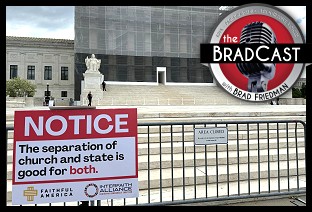 SCOTUS Allowing Publicly-Funded Religious Schools 'Would be a Ground-Breaking Disaster': 'BradCast' 5/7/25
SCOTUS Allowing Publicly-Funded Religious Schools 'Would be a Ground-Breaking Disaster': 'BradCast' 5/7/25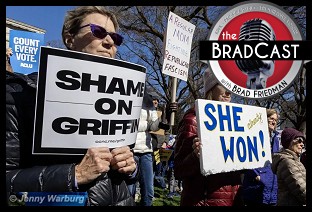 Trump Judge Blocks NC GOP Attempt to Steal 2024 State Supreme Court Election: 'BradCast' 5/6/25
Trump Judge Blocks NC GOP Attempt to Steal 2024 State Supreme Court Election: 'BradCast' 5/6/25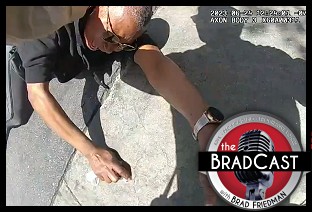 Prosecutors Resign After Trump U.S. Attny Strikes Deal With Felon Cop: 'BradCast' 5/5/25
Prosecutors Resign After Trump U.S. Attny Strikes Deal With Felon Cop: 'BradCast' 5/5/25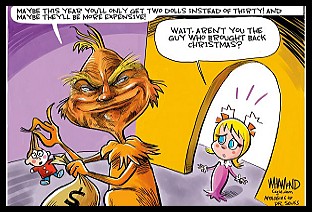 Sunday 'Good Buy, Dolly!' Toons
Sunday 'Good Buy, Dolly!' Toons Trump Losing Streak Continues into SECOND Hundred Days: 'BradCast' 5/1/25
Trump Losing Streak Continues into SECOND Hundred Days: 'BradCast' 5/1/25 'Green News Report' 5/1/25
'Green News Report' 5/1/25 100 Daze: 'BradCast' 4/30/25
100 Daze: 'BradCast' 4/30/25 Campaign to 'Impeach Trump Again' Gains Fresh Momentum: 'BradCast' 4/29/25
Campaign to 'Impeach Trump Again' Gains Fresh Momentum: 'BradCast' 4/29/25 'Green News Report' 4/29/25
'Green News Report' 4/29/25 And Then They Came for the Judges...: 'BradCast' 4/28/25
And Then They Came for the Judges...: 'BradCast' 4/28/25 Sunday 'Desperation' Toons
Sunday 'Desperation' Toons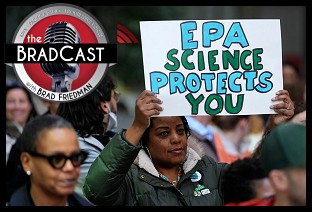 Trump EPA Guts Enviro Justice Office: 'BradCast' 4/24/25
Trump EPA Guts Enviro Justice Office: 'BradCast' 4/24/25 'Green News Report' 4/24/25
'Green News Report' 4/24/25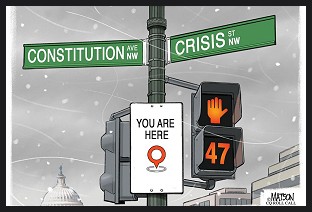 Sunday
Sunday 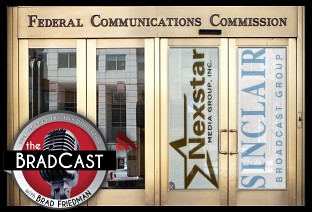 Largest U.S. Broad-caster Hoaxes Viewers to Help Gut FCC Rules: 'BradCast' 4/23/25
Largest U.S. Broad-caster Hoaxes Viewers to Help Gut FCC Rules: 'BradCast' 4/23/25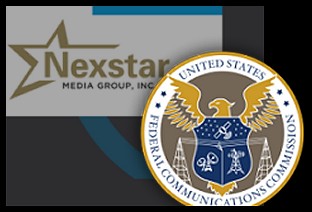 FCC on Precipice of Ending All Limits on Corp. Control of Local TV Stations
FCC on Precipice of Ending All Limits on Corp. Control of Local TV Stations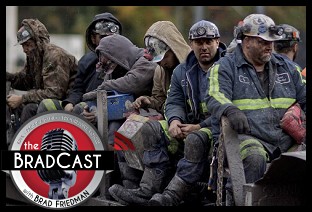 GOP Earth Day 2025 Hypocrisies and Dilemmas: 'BradCast' 4/22/25
GOP Earth Day 2025 Hypocrisies and Dilemmas: 'BradCast' 4/22/25 Pope Francis Dies, Trump Still Alive and Criming: 'BradCast' 4/21/25
Pope Francis Dies, Trump Still Alive and Criming: 'BradCast' 4/21/25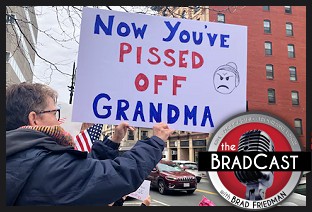 Soc. Sec. Expert Warns DOGE of Collapse, Privatization: 'BradCast' 4/10/2025
Soc. Sec. Expert Warns DOGE of Collapse, Privatization: 'BradCast' 4/10/2025 Trump Blinks, Chaos Reigns, Markets Spike Amid Tariff 'Pause': 'BradCast' 4/9/25
Trump Blinks, Chaos Reigns, Markets Spike Amid Tariff 'Pause': 'BradCast' 4/9/25 SCOTUS Deportation Ruling Grimmer Than First Appears: 'BradCast' 4/8/25
SCOTUS Deportation Ruling Grimmer Than First Appears: 'BradCast' 4/8/25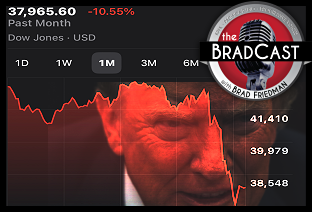 Cliff Diving with Donald: 'BradCast' 4/7/25
Cliff Diving with Donald: 'BradCast' 4/7/25
 VA GOP VOTER REG FRAUDSTER OFF HOOK
VA GOP VOTER REG FRAUDSTER OFF HOOK Criminal GOP Voter Registration Fraud Probe Expanding in VA
Criminal GOP Voter Registration Fraud Probe Expanding in VA DOJ PROBE SOUGHT AFTER VA ARREST
DOJ PROBE SOUGHT AFTER VA ARREST Arrest in VA: GOP Voter Reg Scandal Widens
Arrest in VA: GOP Voter Reg Scandal Widens ALL TOGETHER: ROVE, SPROUL, KOCHS, RNC
ALL TOGETHER: ROVE, SPROUL, KOCHS, RNC LATimes: RNC's 'Fired' Sproul Working for Repubs in 'as Many as 30 States'
LATimes: RNC's 'Fired' Sproul Working for Repubs in 'as Many as 30 States' 'Fired' Sproul Group 'Cloned', Still Working for Republicans in At Least 10 States
'Fired' Sproul Group 'Cloned', Still Working for Republicans in At Least 10 States FINALLY: FOX ON GOP REG FRAUD SCANDAL
FINALLY: FOX ON GOP REG FRAUD SCANDAL COLORADO FOLLOWS FLORIDA WITH GOP CRIMINAL INVESTIGATION
COLORADO FOLLOWS FLORIDA WITH GOP CRIMINAL INVESTIGATION CRIMINAL PROBE LAUNCHED INTO GOP VOTER REGISTRATION FRAUD SCANDAL IN FL
CRIMINAL PROBE LAUNCHED INTO GOP VOTER REGISTRATION FRAUD SCANDAL IN FL Brad Breaks PA Photo ID & GOP Registration Fraud Scandal News on Hartmann TV
Brad Breaks PA Photo ID & GOP Registration Fraud Scandal News on Hartmann TV  CAUGHT ON TAPE: COORDINATED NATIONWIDE GOP VOTER REG SCAM
CAUGHT ON TAPE: COORDINATED NATIONWIDE GOP VOTER REG SCAM CRIMINAL ELECTION FRAUD COMPLAINT FILED AGAINST GOP 'FRAUD' FIRM
CRIMINAL ELECTION FRAUD COMPLAINT FILED AGAINST GOP 'FRAUD' FIRM RICK SCOTT GETS ROLLED IN GOP REGISTRATION FRAUD SCANDAL
RICK SCOTT GETS ROLLED IN GOP REGISTRATION FRAUD SCANDAL VIDEO: Brad Breaks GOP Reg Fraud Scandal on Hartmann TV
VIDEO: Brad Breaks GOP Reg Fraud Scandal on Hartmann TV RNC FIRES NATIONAL VOTER REGISTRATION FIRM FOR FRAUD
RNC FIRES NATIONAL VOTER REGISTRATION FIRM FOR FRAUD EXCLUSIVE: Intvw w/ FL Official Who First Discovered GOP Reg Fraud
EXCLUSIVE: Intvw w/ FL Official Who First Discovered GOP Reg Fraud GOP REGISTRATION FRAUD FOUND IN FL
GOP REGISTRATION FRAUD FOUND IN FL

































